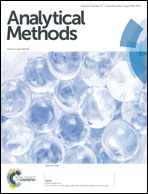Preparation of graphene oxide–fullerene/phosphotungstic acid films and their application as sensor for the determination of cis-jasmone
Abstract
Recent progress in nanotechnology has promoted research in the surface functionalization of graphene oxide (GO) nanosheets owing to their large specific surface area and abundant functional groups. In the present work, cage-structured fullerene (C60) was attached non-covalently to laminar GO through simple grinding, which not only achieved the efficient solubilization of C60 in water but also retained the original physicochemical characteristics of GO and C60. The C60–GO nanocomposite could be dispersed in water with solubility up to 5 mg mL−1 and stability for more than one month. By further combining the redox reversibility of phosphotungstic acid (PTA), a novel electrochemical sensing film (PTA–C60–GO) was fabricated by one-step electropolymerization on a pretreated home-made graphite electrode (GE). This PTA–C60–GO/GE exhibited a sensitive electrochemical response for the direct oxidation of cis-jasmone (CJ), a well-known component of plant volatiles. Under optimal conditions, the oxidation current of CJ increased linearly with its concentration in the range of 0.3–50.0 μmol L−1 with a detection limit of 0.1 μmol L−1. This sensing platform was applied to the determination of the CJ content in rice spikelet samples.


 Please wait while we load your content...
Please wait while we load your content...